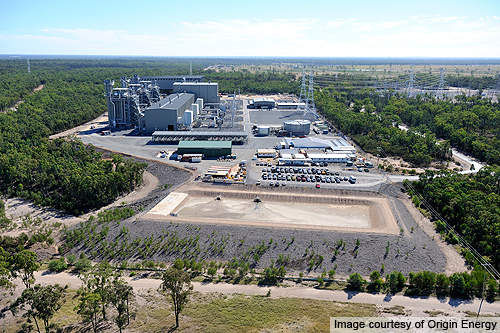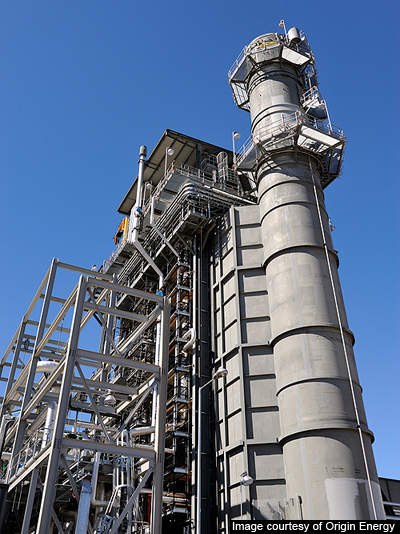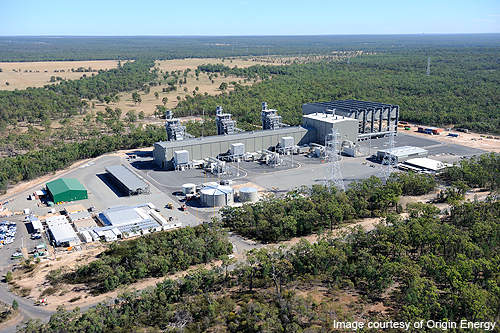Darling Downs Power Station is a 630MW gas-fired combined cycle power plant built by Origin Energy in the Darling Downs region of south west Queensland, Australia.
It is one of the largest and cleanest baseload power stations in terms of carbon emissions in Australia. The plant eliminates about 2.5 million tons of greenhouse gases a year.
The project originally belonged to Sun Retail which was acquired by Origin Energy in February 2007.
Construction works of the $1bn project commenced in August 2007 with the first turbine coming online in December 2009. The power station was fully operational in July 2010.
Electricity produced by Darling Downs is sufficient to power 400,000 homes in Queensland.
Origin Energy bought 77ha of land adjacent to the plant to accommodate future expansion.
Darling Downs Power Station specifications
Darling Downs is powered by three Frame 9E gas turbines and a steam turbine.
The rated capacity of each of the gas turbines is 120MW and that of the steam turbine is 270MW.
The plant also has a water treatment plant which consists of two 100% train systems comprising of cartridge filtration, reverse osmosis, membrane degasification and electrodeionisation.
Queensland plant details
Compressed air and natural gas are mixed in the gas turbine in a combustion process which rotates the turbine generator. Heat coming from the gas turbine is channelled towards the three boilers to produce steam.
Electricity produced by both the gas and steam generators is fed into transformers to boost the power to 275,000V.
The steam is condensed and pumped back to the boilers. The power station uses air-cooled technology which consumes less than three percent of the water used by conventional cooling methods.
Natural gas is sourced from the coal seam gas (CSG) reserves situated in the Roma and Chinchilla regions of south west Queensland. These fields are owned and operated by Origin Energy with co-venture partner, ConocoPhillips UK. A 205km long domestic gas pipeline connecting the CGS fields and the power station was built as part of the project. The plant consumes up to 44 peta joules (PJ) of gas a year.
Grid network
Electricity produced by the Darling Downs power station is transmitted to the Braemar substation where it is stepped-up and then supplied to national power grid.
Contractors involved in Origin Energy’s power station
The turbines and boilers were supplied by GE while the engineering and construction services and the balance of plant were provided by CH2M Hill. The two respective contracts were awarded in June 2007 for a total value of $780m.
Construction and other site activities were managed by Liang O’Rourke under a contract awarded by CH2M Hill while the plant and equipment foundation structures were delivered by Multifix Construction.
The gas-pipeline project management services including the planning, approvals, design, procurement, construction and commissioning were provided by OSD Pipelines. The pipeline project required an investment of about $500m. The contract to construct the 205km long gas pipeline was awarded to Nacap Australia in October 2008. It was based on strict environmental, regulatory and safety and quality considerations.
The water treatment system was supplied by AVANTech.
Scaffolding components such as the basic tube and fittings to the speciality industrial equipment of more than 1,000t was supplied by Uni-Span.
The power station pipelines were fabricated by CDK Engineering on a sub-contract basis for CH2M Hill. Other contractors involved in the fabrication and pipe spooling works was D & R Stainless.
About 55,000m² of acoustic cladding for the Darling Downs power station was done by Queensland Industrial Cladding. Epoxy grout application on the transformer bases was done by Pilbara Fireproofing (PFP) Systems.
The design verification and inspection of the turbines and auxiliary vessels was carried out by Colin Mongta Inspection Services (CMIS).
Energen was responsible for plant commissioning services to Darling Downs Power Station. The operational logging and reporting system was developed by Aberdeen-based Infotechnics with the help of software known as Opralog.
Force Access provided the fleet services for transporting the equipment to the project site.
The fleet was maintained and supported by roster system and on-site technical support provided by Platform Solutions.
Other major contractors involved in the project were Ecofund Queensland for environmental services, Agility Project Logistics for transportation of equipment and components, and FlexiHire for hiring of equipment.






